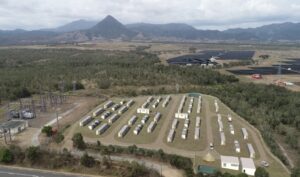Leading utility Origin Energy has revealed it is contemplating five different big battery storage projects in four different states, as an early feasibility study for an expanded pumped hydro project indicated higher-than-expected costs.
Origin, in its annual investor day briefing for analysts in Sydney, said battery storage was being considered as an addition and co-location to four of its existing facilities – the Darling Downs gas generator in Queensland, the Eraring coal and Uranquinty gas generators in NSW, and the Mortlake gas generator in Victoria.
A fifth project, a 300MW solar plus battery proposal called Morgans, is located in South Australia, where there is a growing number of similarly-scal battery projects proposed to support new wind and solar developments.
The scale proposed by Origin is also significant, with 200MW cited for both the Mortlake and Uranguinty projects. That compares to the size of the current biggest lithium-ion battery in the world, the 100MW/129MWh Tesla battery at Hornsdale in South Australia, which on Tuesday confirmed that it will increase in size by 50 per cent to 150MW/194/MWh.
Origin’s rival AGL Energy is also looking at a variety of big battery projects, and has signed a contract for 200MW/400MWh of batteries with the renewable energy developer Maoneng.
EnergyAustralia is also looking at batteries, and currently has contracts for both the Gannawarra and Ballarat batteries in Victoria, while Alinta Energy, which operates a battery next to its gas turbine in the Pilbara, has signed a contract for the big Solar River solar and battery project in South Australia.
Origin is also looking at pumped hydro facilities as part of a growing suite of fast-start and dispatchable generation to fill in the gaps between wind and solar, but it noted that its feasibility studies had produced higher than expected costs.
CEO Frank Calabria also said that the company’s coal generator, Eraring, the biggest coal generator in the country, is also increasing its flexibility so it can support wind and solar.
Origin has vowed to exit coal by 2032, the scheduled date for the closure of Eraring, and it notes that some 8GW of coal generation is scheduled for closure over the 10 year period leading to that date.
But Calabria also noted that investment was difficult in the current political and regulatory environment.
He said government intervention and the shift to central planning has created uncertainty for investors, echoing the criticism from the industry over the federal government’s backing of Snowy Hydro and its short listing of projects under its UNGI (underwriting new generation investment) projects.
“Investment in flexible, fast- start technology is required to support renewables …. (but) current policy environment makes investment decisions in generation challenging,” Origin says. “Strong market signals are required to incentivise the right investments at the right time.”
Calabria also noted the shift to decentralised technology. A centralised grid would still account for at least half of all supply, but that will be increasingly dominated by renewables, with wind and solar clearly the cheapest form of generation.
On the other side, the emergence of decentralised energy would reflect more customer choices, not just for rooftop sola but also battery storage, and electric vehicles. This, in turn, would lead to IoT (internet of things) devices, two-way power flows, and greater customer value from connecting and sharing distributed assets.










